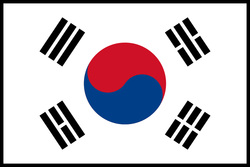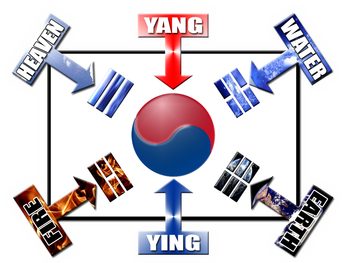KOREAN FLAG (TAEGUEK-KI)

The meaning of Korean National Flag is very philosophical. The origin comes from the Oriental philosophy called Eum-Yang, in Chinese pronunciation Yin-Yang. In Korea, the symbol of 'Yin and Yang', and sometimes the flag itself, is called Taeguk and summarizes the thoughts of 'I Ching' (called 'Yeok' in Korean).
KOREAN FLAG SYMBOLS REPRESENTATION

The flag consists of three parts: The white background, the red and blue circle in the center and four trigrams, one in each corner of the flag.
The white background of the flag means peace.
The red and blue circle in the center is called 'Taeguk', the origin of all things in the universe. The central thought is perfect harmony and balance: A continuousl movement within the sphere of infinity, resulting in one unit. The blue part of 'Taeguk' is called 'Eum' and represents all negative aspects of the balance that is typical for the symbol. The red part is called 'Yang' and describes all positive apects.
The four trigrams at the corners (called 'Kwe' in Korean) also represent the concept of opposites and balance. The trigrams are heaven (upper-left) and at the other corner earth, water (upper-right) and at the other corner fire. Looking at symbols of the trigrams, you can see that they are opposites as well. Three unbroken bars (heaven) vs. three broken bars (earth), etc.
For the Korean people their flag of T'aeGuk-Ki is a source of pride and inspiration. During the Japanese occupation period beginning in 1910 the Korean flag was outlawed in public places and for about thirty five years the T'aeGuk flags were kept hidden until Liberation Day in1945. The Korean flag has been a symbol of this country's struggle for independence and freedom.
Origin
The oldest 'Yin/Yang'-symbol, which was described in stone, was found in Korea. At the end of the 19th century, Korea needed their own flag. It is believed that Young-Hyo Park came up with the first concept. At that time, Korea was under the influence of all sorts of colonists like the Japanese, Chinese and Russian.
The symbols
Yin means dark and cold, while Yang means bright and hot. A very old book called Choo-Yuk which is written by a Chinese claims all objects and events in the world are expressed by the movement of Yin and Yang. For example, the moon is Yin while the sun is Yang. The earth is Yin and the sky is Yang. The night is Yin and the day is Yang. The winter is Yin and the summer is Yang. Yin and Yang are relative. Therefore, A can be Yin with respect to B while A can be Yang with respect to C. For example, the spring is Yin w.r.t. the summer and it is at the same time Yang w.r.t. the winter
The white background of the flag means peace.
The red and blue circle in the center is called 'Taeguk', the origin of all things in the universe. The central thought is perfect harmony and balance: A continuousl movement within the sphere of infinity, resulting in one unit. The blue part of 'Taeguk' is called 'Eum' and represents all negative aspects of the balance that is typical for the symbol. The red part is called 'Yang' and describes all positive apects.
The four trigrams at the corners (called 'Kwe' in Korean) also represent the concept of opposites and balance. The trigrams are heaven (upper-left) and at the other corner earth, water (upper-right) and at the other corner fire. Looking at symbols of the trigrams, you can see that they are opposites as well. Three unbroken bars (heaven) vs. three broken bars (earth), etc.
For the Korean people their flag of T'aeGuk-Ki is a source of pride and inspiration. During the Japanese occupation period beginning in 1910 the Korean flag was outlawed in public places and for about thirty five years the T'aeGuk flags were kept hidden until Liberation Day in1945. The Korean flag has been a symbol of this country's struggle for independence and freedom.
Origin
The oldest 'Yin/Yang'-symbol, which was described in stone, was found in Korea. At the end of the 19th century, Korea needed their own flag. It is believed that Young-Hyo Park came up with the first concept. At that time, Korea was under the influence of all sorts of colonists like the Japanese, Chinese and Russian.
The symbols
Yin means dark and cold, while Yang means bright and hot. A very old book called Choo-Yuk which is written by a Chinese claims all objects and events in the world are expressed by the movement of Yin and Yang. For example, the moon is Yin while the sun is Yang. The earth is Yin and the sky is Yang. The night is Yin and the day is Yang. The winter is Yin and the summer is Yang. Yin and Yang are relative. Therefore, A can be Yin with respect to B while A can be Yang with respect to C. For example, the spring is Yin w.r.t. the summer and it is at the same time Yang w.r.t. the winter
